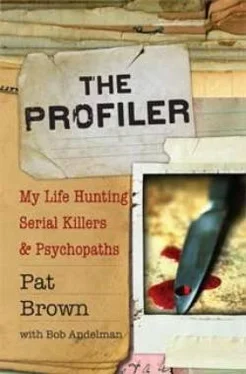Following the homicide, the killer washed his hands in the bathroom. This shows, first, that he wore no gloves and I wondered, What hit man would neglect that issue? Second, having just committed a homicide, it would seem wise to vacate the premises immediately and not waste time in washing up. That could have been accomplished anywhere. He stopped in the bathroom to wash his hands. Either the sign of an extraordinarily nonchalant killer or a total amateur who was horrified by the sight of blood on his hands; the blood of his victim as it flew back at the hand holding the gun.
Also, the killer looked in on the children. Why? What interest, if he wasn’t a rapist, would he have in checking out sleeping kids? And, since there were teenage girls in the house, a rapist would have been more than pleased to make such a find. But he peeked in and then left the house.
Doris Hoover was shot in the mouth with a small caliber handgun. Shooting women in the mouth is usually a sign of rage. The anger is directed at the woman’s mouth, where the voice is coming out and telling you what you don’t want to hear.
The strangest behavior of all in this crime, outside of the fact that the killer called for emergency medical help in a bizarre attempt to save Doris ’s life, was that he left the house but then came back.
This brought me to consider what behaviors occurred at the crime scene that could identify the motive and personality of the offender.
I believed the killer was comfortable in the Hoover home. He knew his way around it either because he had been in the home before or he lived in a nearby home of the same design.
The forced entry was likely staged, perhaps as an afterthought when the killer realized the murder would not look like a stranger homicide.
It was theorized that the perpetrator also took Doris ’s purse to add to the staging effect and mislead the investigation to focus on robbery as a motive. Clearly, since nothing else of value was taken, this crime was not a robbery. However, I do not believe that the motive for taking the purse was to steer the investigation off course. The killer left the house after shooting Doris and then returned and went back upstairs into her room and left the house a second time. It is unlikely that the killer would waste yet more valuable time staging a robbery, minutes spent that would increase the chance of apprehension.
The family does not remember the exact whereabouts of Doris ’s purse that night. Her daughters believe it was either in her bedroom or under a coat on the living room couch. If it were hidden under a coat on the couch, it is not likely the killer knew it was there and took it. More likely, it was in her bedroom. It was my belief that the purse may have contained some item of interest to the killer that was worth coming back for. It was also possible that the killer came back to check and see what condition Doris was in and took the purse upon leaving the room as a possible afterthought. At this same time, he may well have noticed that Doris was not dead but asphyxiating (because of bodily fluids running into her lungs). This may have prompted the call for medical assistance. It is also interesting to note that the killer, on the return to her room, did not take this opportunity to make sure she was dead.
The killer did not wear gloves. This indicated that he did not plan to commit murder. Perhaps he only wanted to talk with her or show her how angry he was. He may not have worried his fingerprints would be considered evidence of his involvement in the crime if he had previously spent enough time in the house.
But Laurie reported that the killer had wiped off the doorknob of the children’s room after he opened the door-it was always closed-and looked in. However, there may be other explanations for the perpetrator to have applied a rag to the doorknob. Laurie heard the man go into the bathroom and then she saw him at her door wiping off the doorknob. The bathroom light was on and the hallway was illuminated. He was tall and thin and wore a winter hat, denim shirt with long sleeves, and dark pants, and his head was turned back toward Doris ’s bedroom. It was possible that, following the crime, he went from Doris ’s room straight to the children’s room to look in and see if the shot had awakened them. The fact that he went into the bathroom and washed his hands indicated he had blood on them, most likely caused by back spatter from the gunshot wound. He may have left bloody fingerprints on the door to the kids’ room that he then wiped clean. Considering that the man wore no gloves to begin with, I wondered why he wiped down that door alone if his only interest was eradicating fingerprints, and not bloody fingerprints, from the residence.
That the killer took time to wash his hands indicated he was not comfortable with blood on his hands. It would therefore be unlikely that this person was a hit man or a hardened criminal.
And the fact that the killer looked into the bedroom of the children and did not attempt to harm them showed he had concern for the children and no ill will toward them.
The lack of clear forced entry meant the killer was either admitted to the house, had a key to the house, or entered through an unlocked door or window, perhaps one he had left open before so he could get back in.
Laurie claimed to have heard him leave the house; she heard the screen door slam closed.
Then, terrified, she heard him come back into the house and go into Doris ’s room. She believed he took something from the room and went back downstairs, where she heard something fall-she later discovered it was a box of crayons. She never heard the sound of a car.
Laurie later heard the voice recording of the killer’s call to her father’s fire station that reported the shooting. She thought the low voice sounded like it belonged to a black man, although “it could have been somebody with a Southern twang accent.” It was not a voice Laurie recognized. Either the killer was someone Laurie did not know or he disguised his voice so he would not be recognized. A Southern accent is one of the easier speech patterns to mimic-even if to a Southerner the effort might be laughable.
A person who wanted Doris dead, or didn’t care if she died, and didn’t care if the kids found her body, would not have made the call. The killer also knew the Hoovers ’ exact address, indicating he was familiar with the location-so familiar that he would have had to live nearby or be a regular visitor to the point of knowing the address. In theory, the killer could have walked outside to get the address or looked at mail lying about to get it, but again, it was unlikely he would do this for any reason except to attempt to save Doris ’s life.
THERE ARE A number of versions of the events of the evening at the Hoovers ’ home prior to the homicide.
The most interesting discrepancy, reported by the other sisters, involved an older sister, Debbie, who was married and did not live in the residence, and Debbie’s friend Carl Barlow, who sometimes visited Doris without Debbie, and the issue of Debbie bringing a dog over to show Doris.
Her sisters say that in the early days of the investigation Debbie said she had been at the house with Carl, showing off her new dog. But when I spoke to her she said that Carl had visited separately before she had arrived that night. Debbie’s sisters also say that Debbie told them that both she and Carl had witnessed Doris arguing with Mickey over the phone. Carl, likewise, seemed to not remember exactly who was where and when. Carl told me that he couldn’t remember if he and Debbie were there together or not that evening.
Also, there was the issue of the argument ensuing on the phone that evening between Mickey and Doris Hoover. Mickey did not remember such an argument that evening.
Читать дальше












